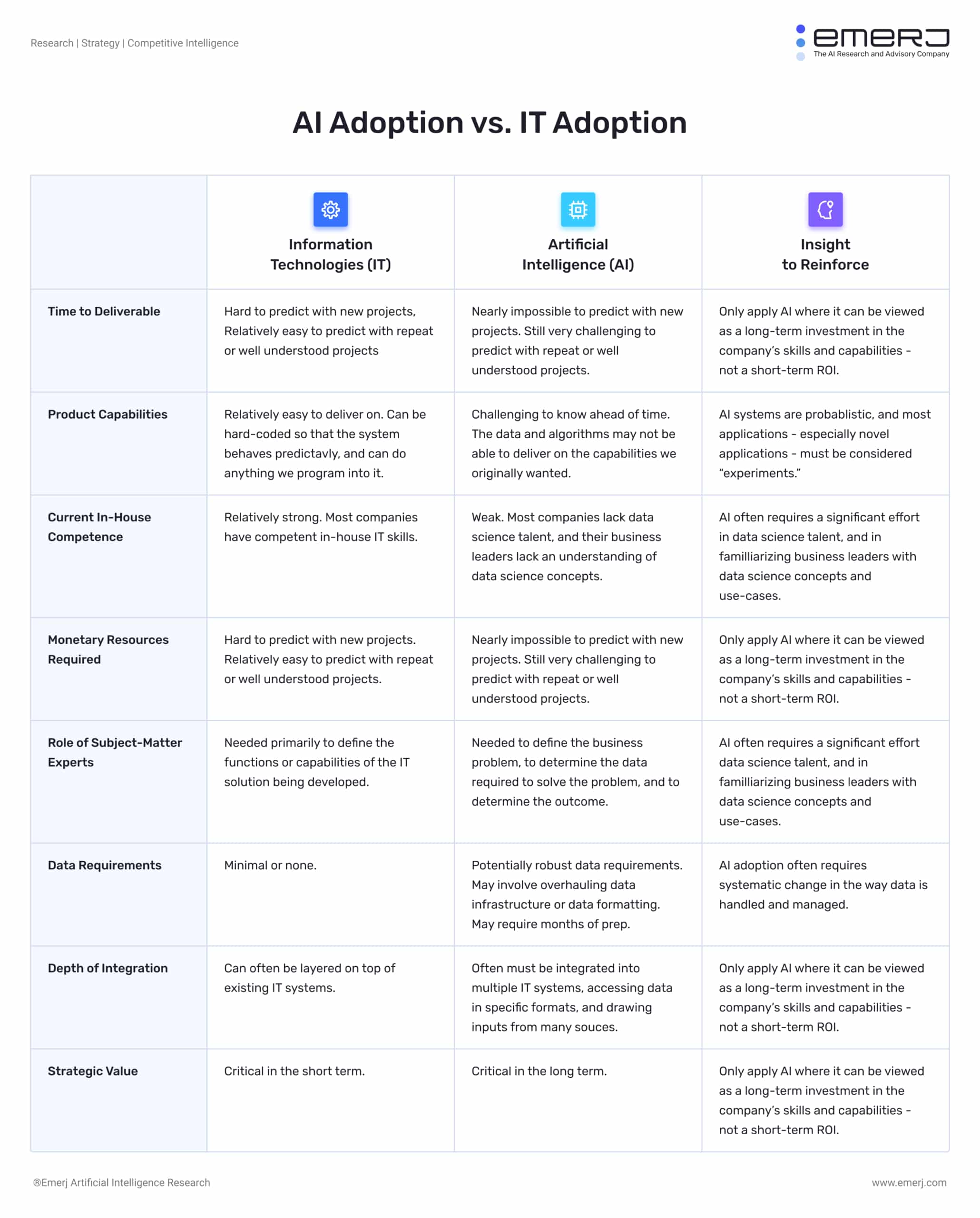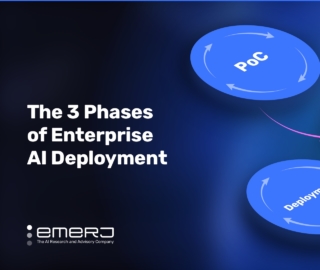
One of the biggest hurdles to AI adoption and integration is a lack of proper expectations about applying AI in an existing business. Executives and their teams often go into the process blind because so few companies have learned these important lessons and challenges and because even fewer have successfully adopted AI in a way that delivers ROI.
Teams often must learn the hard way that AI is not IT.
AI isn’t just a new set of tools, it’s a new way of working, a new set of expectations. As enterprise AI veteran and Emerj podcast guest Dr. Charles Martin has stated:
IT is deterministic (if this, then that), AI is probabilistic (let’s experiment and see if this data, and this algorithm, can achieve this result). IT is often predictable, AI is like R&D.
Going into AI projects unprepared often implies ignorance of these differences, and subsequently poor expectations set for AI projects. When expectations are set poorly (unrealistic time to ROI, not accounting for preliminary data cleaning, etc), leadership gets disappointed, and projects and budgets get shut down.
In this article, we’ll prepare aspiring AI teams for the specific challenges they’ll face, by contrasting them with similar processes in IT.
We’ll begin with a useful infographic highlighting many of the main differences between AI and IT, and how to take them into account in practice (below).

In the remainder of the article, we’ll explore five of the most important considerations for AI deployment: Data, data science talent, teams and leadership, iteration, and (other) deployment challenges. For each point, we’ll highlight the challenges and summarize the specific expectations that AI project teams should have as they enter their projects.
1. Data
Data is essential for any AI application, but data quality and data access are often challenging hurdles to AI adoption. For established businesses, particularly businesses built before the popular use of the internet, data storage is siloed, and little thought is given to data formats. For many companies, data is stored so that it can be manually found or potentially so that it can be used for dashboards and basic business intelligence purposes.
Artificial intelligence requires that data formatting be unified and that data be accessible by AI systems, sometimes in real time. This often involves not just “cleaning” (properly formatting the data, getting rid of inaccurate or unusable data files) data but often overhauling data infrastructures and changing legacy systems altogether. For this reason, small AI pilot programs can be relatively easy to test, but sustained AI use as part of a business function implies greater changes to core IT systems, which can be costly, and uncertain in ROI.
What to expect about data:
- It’s harder to access than usually anticipated
- It requires heavy organizing and sorting in order to format it, and purge unusable files
- It will often require entirely new infrastructure to implement AI sustainably
Related article: Fundamentals of Data Literacy
2. Data Science Talent
Data science talent is critical for bringing a true AI initiative to life inside of an existing business. Relying entirely on consulting firms (many of whom are extremely understaffed in real data science talent of their own) is risky and unsustainable for true adoption of AI into any core business process.
Data science talent will be necessary for evaluating potential AI initiatives, for setting up and handling data infrastructure, and for iterating and adjusting algorithms and data to achieve a business result. This involves regular interfacing with business leadership or functional leaders in a given business department.
Data science is in high demand, and prospective employees with these skills will want more than money. They want a rewarding career working on problems that really matter in the world and really matter to their employer. They want support from leadership to get access to the tools they need, and they want functional leaders around them who understand the basic concepts of data science (not technical, just conceptual) and can work with them to solve problems.
What to expect about AI talent:
- Hiring AI talent is expensive and will require a compelling reason as to why your AI initiatives are interesting and valuable for the company. Expect to experiment with different ways of framing your data science role so that it captures attention
- Retaining AI talent means finding a productive role and tangible, important data science projects
- It is challenging to determine how a data science expert will work with other members of the IT team, and with business leadership
Related podcast: Why Executives Should Follow AI Trends in Business
3. Teams and Leadership

While data science is critical, so is the “connective tissue” that surrounds that data science talent. We use “connective tissue” to imply the IT team, the functional business leaders, and the relevant subject-matter experts who will need to engage with the data science talent in order to solve problems.
Throughout this article, “subject-matter experts” will refer to business team members with deep expertise in the business processes (i.e. accounting) or field (i.e. petroleum engineering) that a given AI initiative is related to.
An AI project team will need to be led and/or approved by an in-house “champion”, an executive leader who understands the scope and goals of the project, the estimated costs of the project. The champions must believe in the strategic value and necessity of the initiative, and be willing to support the project with guidance, resources, and enthusiasm.
These teams will need to work together in order to:
- Determine the business problem an AI solution can solve: Data scientists need context on what problems mean, on what data is necessary, and on what data is accessible, and IT/business team members will need to help.
- Determine how AI can solve that business problem: Data scientists will have ideas about how AI might detect fraud or might predict events for business leaders, but business/IT team members will need to be present to guide or contribute to the project, including a clarification of the output of the interface. This clarification might include answering questions such as, what will it “look like” when it’s done? How will the system act? What actions will the system take automatically, and which need human oversight?
- Maintaining and updating the system once it’s built: Constant iteration is needed in order to make AI systems deliver results. Calibrating a system over time not only involves technically tweaking the data and algorithms but using business context to determine whether the system is working. This is not a job for data scientists alone.
It should be noted that while data scientists and executives are more frequently involved in strategic planning conversations, it is often hard to pull in-house subject-matter experts from the core tasks that they are employed to do. Leadership must either (a) restructure the schedule and incentives of the involved subject-matter experts, or (b) hire outside subject-matter expert consultants to work in a dedicated fashion for the length of the project.
What to expect about teams and leadership when adopting AI:
- Initially, IT and business employees will subtly resist taking time away from their regular work to interact with data scientists
- Expect to reinforce the importance of these interactions and to make up for the lost time in core IT and business work
- Expect to develop new playbooks and workflows for how AI projects are initiated, measured, and kept up over time
4. Iteration
Getting a machine learning system to work in business isn’t easy. After accessing the necessary data, building a team, and selecting the right projects, there is more work to be done. AI is not like “doing IT;” it is like “doing science.” There is no plug-and-play method to make AI come to life: only tests.
Some applications involve wholly trained systems, such as security AI applications that detect people or vehicles in a live video stream. Such an application involves a pre-trained model that handles a problem that won’t change much (the appearance of humans and vehicles).
Most business problems involve handling bespoke business data in messy formats and taking educated guesses about what data and what algorithm might get a result. Months of testing and tweaking are often required to get an AI system to perform on par with humans or previous software systems.
Even when a system is built, there must be ongoing attention paid to the outputs of the system, ensuring that odd trends of faulty data haven’t thrown off the system’s results. This involves both measurement of the system’s results and tinkering with the data and the algorithms. This ongoing process is usually nowhere near as challenging as the initial process of setting up an AI application.
What to expect in terms of iteration and calibration of AI systems:
- Systems will require significant trial-and-error in order to approach human-level performance or an acceptable level of performance
- Some systems may degrade to a point of failure, and will need to
- Expect ongoing measurement and maintenance of algorithms
5. (Other) Deployment Challenges
A variety of other issues might come up to prevent or delay an AI system from being deployed, including:
- Legal or regulatory concerns: Heavily regulated sectors (like healthcare and finance) must ensure that their AI applications aren’t in violation of any laws. In-house legal staff should sign off on an AI initiative early on, rather than waiting until deployment. Other applications such as recommendation engines or targeted marketing applications might stir a PR nightmare, and last-minute executive concerns on these matters can often be prevented by planning for and considering these impacts from the outset of an AI initiative before sinking resources into it.
- Data access: Getting a pilot AI application to work is often done with stagnant older data, just enough to test the concept. Deploying such an application often involves ongoing access to data (in real-time or in relatively regular intervals). This sometimes requires manual and monotonous human effort (not ideal, but sometimes necessary) or an overhaul of data infrastructure built for data access and compatibility with future AI plans. This makes deployment especially challenging in older enterprises.
- Losing a champion: Not every C-level executive or functional business leader will be excited to experiment with AI. In addition, even those who are excited often don’t have the proper context on AI’s capabilities or understanding of its requirements. If the right champion of a project moves to another department or another company, the funding and resources needed for an AI initiative may disappear as quickly as the champion themselves. Securing a committed, long-term connection to the C-suite (or whichever party holds the budget) is critical.
What to expect when it comes to deploying AI:
- Unplanned hurdles will arrive between starting and deploying an AI initiative, especially for the first few AI projects
- Prepare to record these hurdles and determine a playbook to move beyond them, starting with some of the simple advice in this article
Related interview: Practical AI Ethics – Impacts on the Bottom Line
Concluding Note – Bracing for Change
Because of the great number of unique challenges presented by AI adoption, we advocate that leadership focus on retaining AI lessons learned. The following quote from our article AI Knowledge Retention in the Enterprise should be reiterated:
Implement a successful AI initiative with an enterprise team, and they’ll derive near-term value.
Level up the AI fluency and understand of an enterprise team, and they’ll have the ability to discover and deliver AI projects into the future.
And AI fluency comes by actively learning from experience, and aiming to not only see near-term results, but to set the stage for the easier, nimbler use of AI into the future.
Most firms will never hit on a monopoly-level data flywheel like Google or Amazon or Netflix.
Most individual enterprise AI deployments will never bring lasting competitive advantage.
But all firms can build AI maturity, and can learn to spot AI opportunities/deploy them well. THIS is a competitive advantage – and it’s open to nearly any company that is open to retaining their AI lessons learned and consciously improving.







